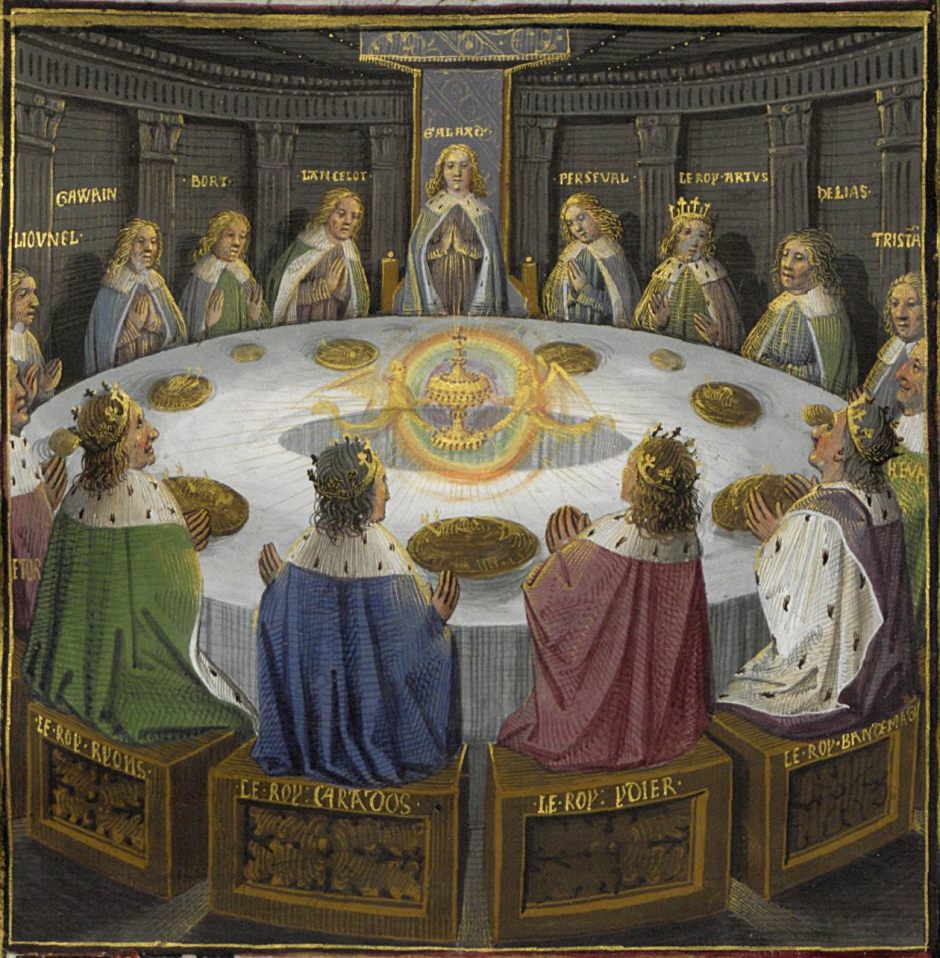For many who gave their accounts of the legends of Arthur and his knights of the Round Table, the central story is the quest for the Holy Grail, and the role of Sir Galahad. According to Sir Thomas Malory, Sir Galahad was the son of Sir Lancelot du Lake, whose birth was foretold to King Arthur and his knights by an old hermit, who told them that he would be the occupant of the one empty seat at their Round Table, the Seat Perilous.
Sir Lancelot healed a lady who had been in pain for five years as the result of one of Morgan le Fay’s curses. Lancelot and the lady went to praise God afterwards, and while in the chapel he killed a dragon that had been living in one of the tombs. King Pelles, the local monarch, thanked Lancelot for his deed.
Pelles told Lancelot that he was descended from Joseph of Arimathea, and showed him the Holy Grail. The king wanted the knight to lie with his daughter Elaine and make her pregnant so that she could give birth to Sir Galahad. Pelles therefore arranged for an enchantress to trick Lancelot into believing that Elaine was Queen Guenevere, and the couple spent the night together in a castle. The following morning the spell over Lancelot was broken, and he realised that he had been deceived. Elaine persuaded him to see reason, but he rode off leaving her expecting their son.
The young Galahad was born and raised in the court of King Pelles, and was prophesied as being the greatest knight, who would achieve the Holy Grail. One Pentecost, Sir Lancelot and his cousins Sir Bors and Sir Lionel were introduced to the young Galahad in an abbey of nuns. After the three knights had feasted with Galahad, the following morning Lancelot dubbed his son a knight, but Galahad wouldn’t return with them to Camelot.
After they had attended mass on Whitsunday, the knights of the Round Table saw gold letters on Seat Perilous, directing that it should be filled that day, 454 years after Christ’s Passion. Just then, a squire announced that he had seen a stone floating in the river, in which was stuck a sword bearing words stating that the only man who can draw the sword from the stone is the best knight in the world. (This is almost identical to the process by which the young Arthur had proved himself as King of Britain, earlier in Malory’s account.) King Arthur invited Lancelot to try to draw the sword first, but he declined. Neither Sir Gawain nor Sir Perceval were able to draw the sword, so the knights adjourned for dinner.
Once they were seated at the Round Table, with just Seat Perilous empty, an old man in white introduced the young Galahad to them, and sat him down in Seat Perilous, where letters stated that was his seat. After they had eaten, King Arthur took Galahad to see the floating stone and the sword embedded in it. The young knight had no difficulty in drawing the sword from the stone, so justifying his place at the Round Table, in Seat Perilous.

Arthur Rackham’s 1917 illustration of How Galahad drew out the sword from the floating stone at Camelot for The Romance of King Arthur shows the young knight proving himself in the same way that King Arthur had done before with a sword embedded in an anvil.
The following day, after jousting demonstrated Sir Galahad’s skills, the knights sat at the Round Table for supper. There was a noise like thunder, and a brilliant sunbeam shone into the room. The Holy Grail then appeared in the midst of them, and disappeared once they had finished their meal. It was Sir Gawain who first spoke up to announce that he would leave on his quest for the Holy Grail, and the other knights quickly vowed that they would join him.

This miniature from about 1475 by Évrard d’Espinques is helpfully labelled with their names. Sat in Seat Perilous is Galard or Galahad, Percival is here named Perceval and went on to be known elsewhere as Parsifal, and King Arthur is labelled Le Roy Artvs. You don’t have to be particularly observant to notice that there aren’t 150 knights at this Round Table.
The next day, to the sorrow of King Arthur, all one hundred and fifty knights of the Round Table made their farewells, and left on their quest for the Holy Grail.

One of the first nineteenth century artists to respond to the contemporary rekindling of interest in Arthurian legend was the Scottish painter William Dyce. This watercolour was the study for a fresco he painted in the Queen’s Robing Room in the Palace of Westminster (Houses of Parliament). It shows a melée of knights of the Round Table paying tribute to King Arthur and Queen Guenevere (at the right), as those knights prepare to depart on their quest for the Holy Grail. It is perhaps the Arthurian equivalent of Frith’s Derby Day.

In the 1890s, William Morris’s company created sets of six tapestry panels telling the story of the quest for the Holy Grail. Much of the artistic work was performed by Sir Edward Burne-Jones, with Morris mainly concerned with the design, and the younger John Henry Dearle responsible for floral and other details. The first set was made for Stanmore Hall in Shropshire. This image of The Arming and Departure of the Knights shows the panel made for the second set in 1895-96.
The following night they stayed together at a castle, then the next morning they each went their separate ways on their quest.
Reference
Dorsey Armstrong (translator and editor) & Sir Thomas Malory (2009) Morte Darthur, a new modern English translation, Parlor Press. ISBN 978 1 60235 103 5. (A superb translation based on the Winchester manuscript.)

